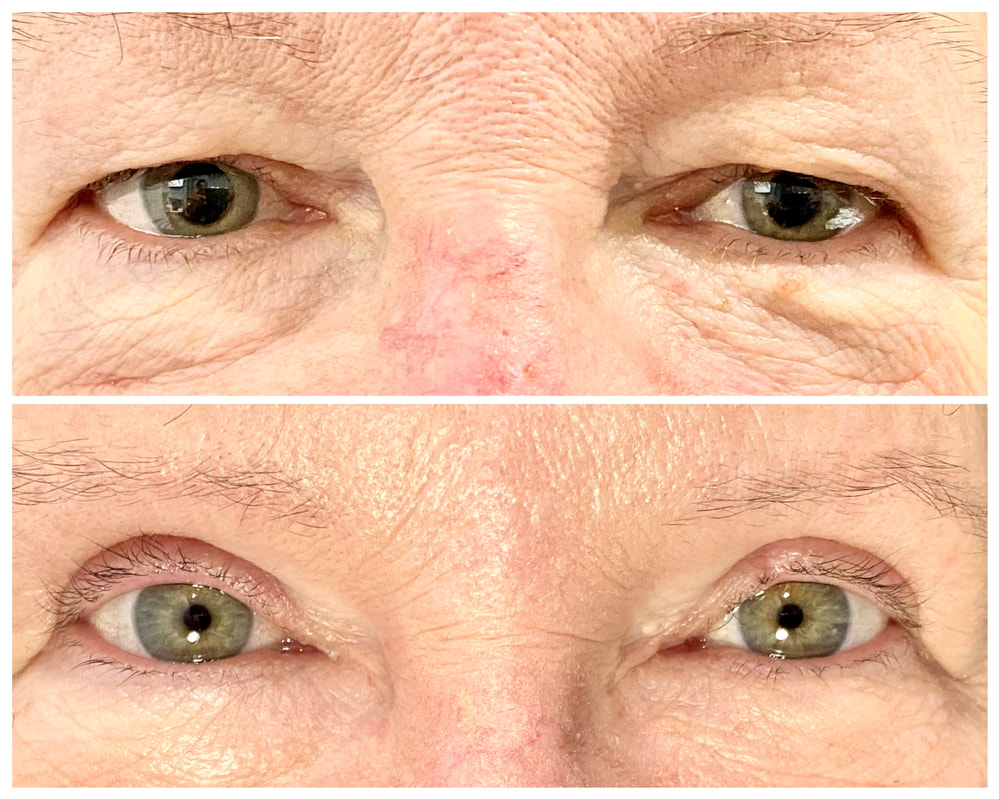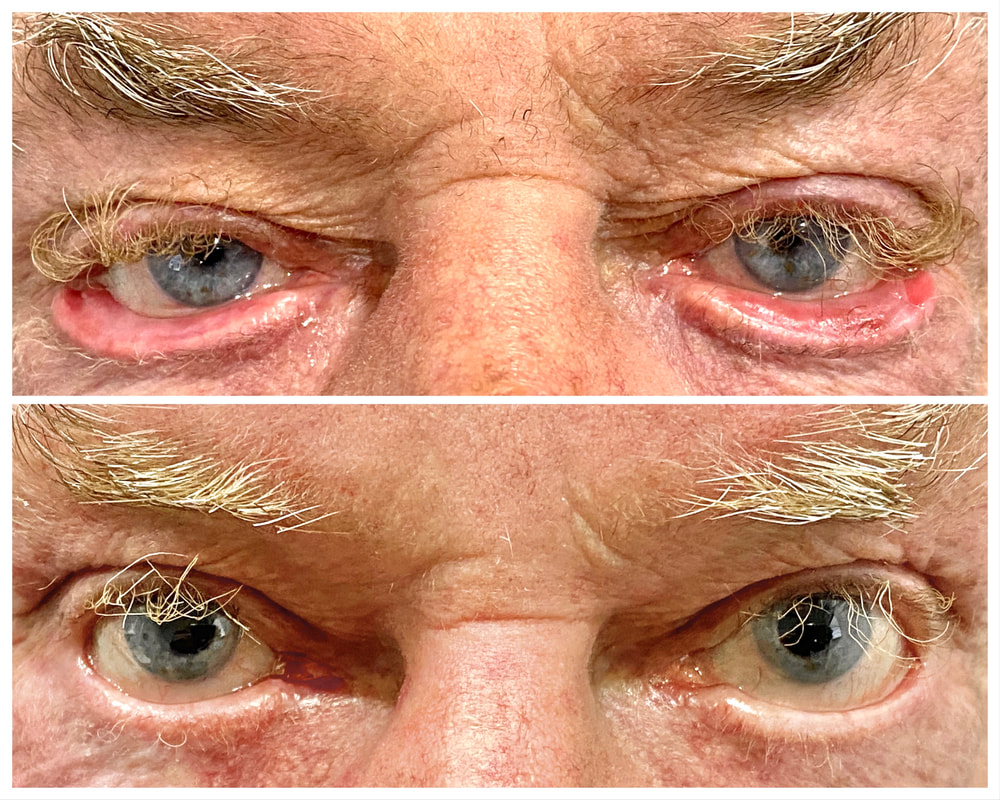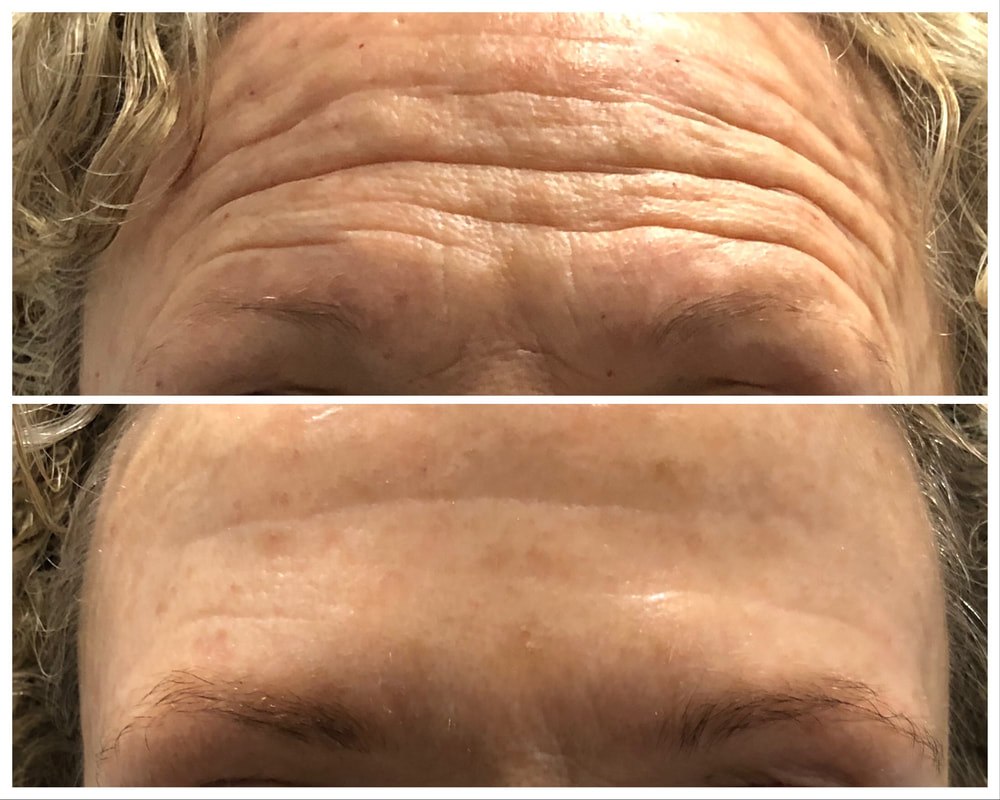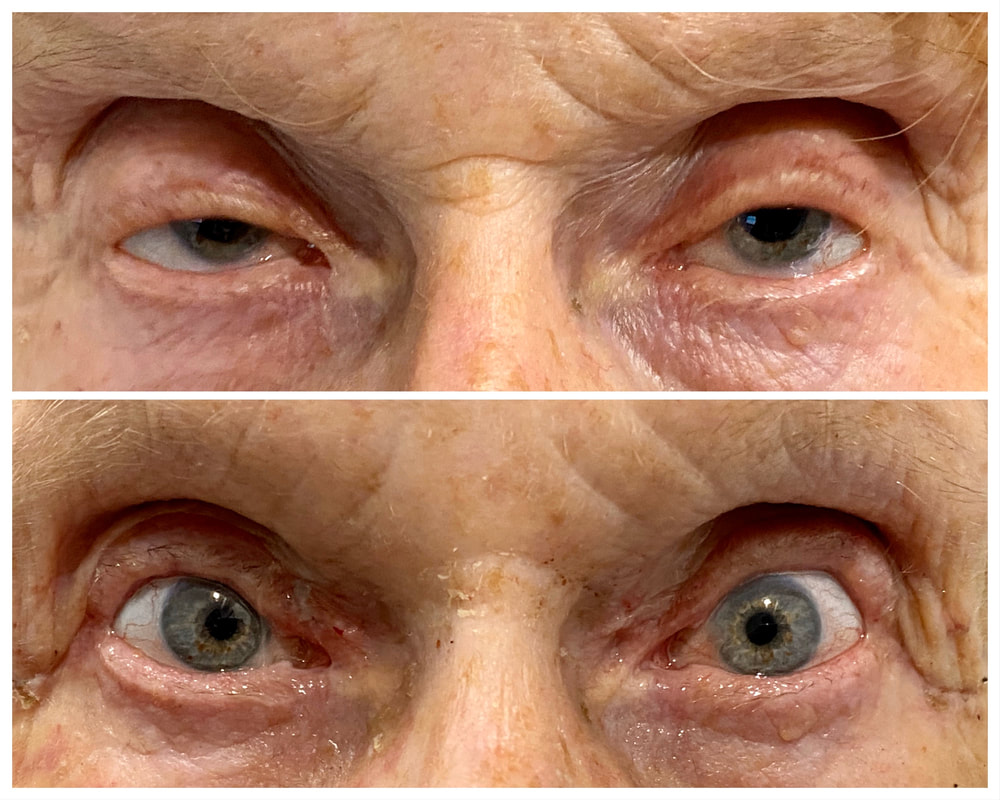Browse through the sections below to read about and view photos and videos showing various conditions of the eyes, tear ducts and eyelids and their treatment
Outcomes shown are only relevant for the individual patients shown and do not necessarily reflect the results other patients may experience, as results may vary due to many factors including the individual’s genetics, diet and exercise
Blepharoplasty
Upper blepharoplasty
Too much upper eyelid skin can sometimes hang down over the eyes resulting in a tired, or angry appearance. This condition is now as dermatochalasis. When severe, this can cause the upper eye lid lashes to curl in and scratch the surface of the eye causing irritation. Sometimes the loose upper eye lid skin can even block a person's vision.
Surgery to remove the excess upper eye lid skin is known as upper blepharoplasty. It takes about 30 minutes to 1 hour and is done as a day procedure, not requiring overnight admission. Stitches are removed at 1-2 weeks. The stitch line is very fine and hidden under the natural fold of the upper eyelid and so, is invisible.
Surgery to remove the excess upper eye lid skin is known as upper blepharoplasty. It takes about 30 minutes to 1 hour and is done as a day procedure, not requiring overnight admission. Stitches are removed at 1-2 weeks. The stitch line is very fine and hidden under the natural fold of the upper eyelid and so, is invisible.
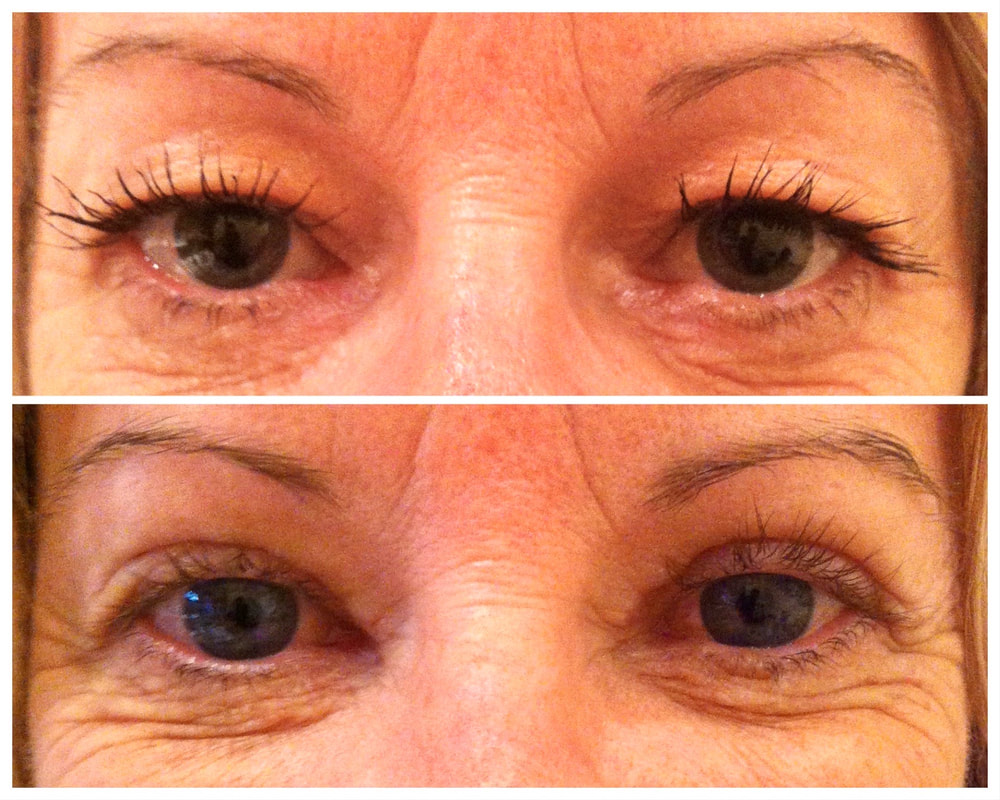
In the before and after picture here, selected from a file of an actual patient of Dr Lee's, the upper preoperative picture shows a tired and angry appearance. The excess skin of the upper eyelid rests on the eyelashes. In time, the pressure from the excess upper lid skin can become so severe it can push the eyelashes inward to scratch the surface of the eye causing eye irritation and redness.
In the lower postoperative picture, after an upper blepharoplasty operation, the eyes appear more open. The tired/ angry look is gone and the eyes appear fresh, friendly and smiling. The eyelashes now curl up, as they should, and are no longer taking the weight of excess skin. If desired, anti-wrinkle injections can reduce or remove any wrinkles and can also be used to achieve a nonsurgical eye brow lift.

Sometimes, in the older patient, excessive upper eyelid skin can start to hang over a person's eyes so much that it can block their vision. In the upper preoperative picture, the excess upper eye lid skin casts a shadow over the patient's vision and blocks the upper field of view. This can be measured on a visual field test. In this situation, a blepharoplasty operation becomes a medical necessity.
In the lower postoperative picture, the hooding of the eyes is removed. It can be seen that this surgery improves the function of a person's vision but also enhances the appearance in an age-appropriate way
Lower blepharoplasty
Some people have baggy or bulging lower eye lids. This is cause by sagging of the facial skin as well as bulging forward of fatty tissue that normally sits behind the eyelids. When this occurs a dark line can show beneath the eye bags resulting in a tired, aged look. A lower blepharoplasty is performed to smooth out the dark line by spreading the fatty tissue - a procedure known as fat repositioning. The procedure takes 1-1.5 hours and is done as a day procedure not requiring overnight admission.
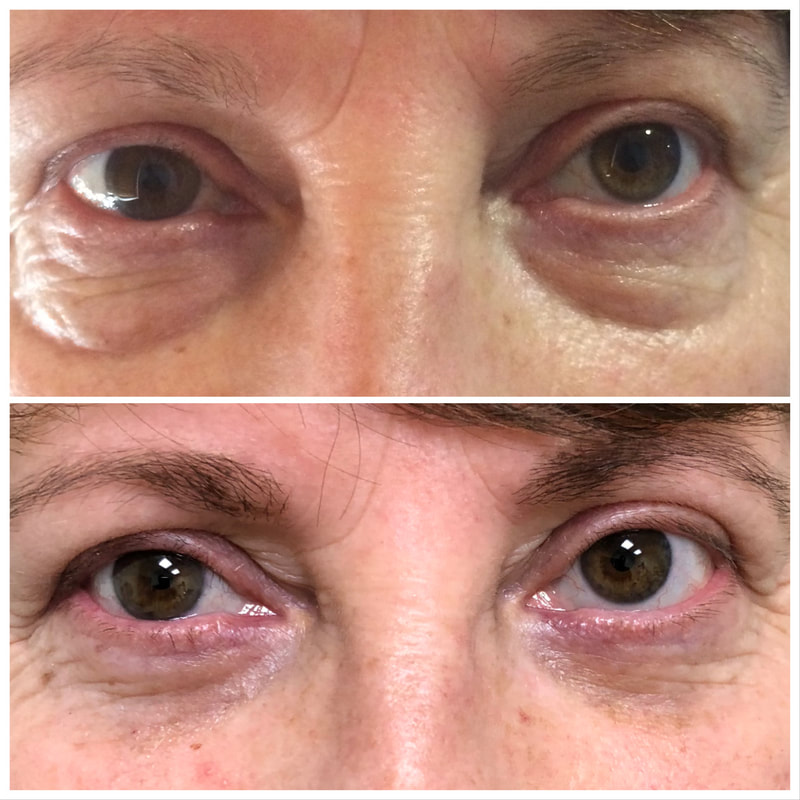
In the first picture, before a lower blepharoplasty operation, there are large bags beneath the eyes. These are lumps of fatty tissue that bulge forward once the facial tissues begin to droop with age. The lumps form a prominent skin crease known as the tear trough. These are responsible for shadows under the eyes, causing a tired look.
In the lower picture, after a lower blepharoplasty operation performed by Dr Lee, the fatty tissue has been spread into the area below to smooth out the tear trough skin crease formed by the bags. The mild discolouration or darkening of the skin below the eyes is due to bruising from the operation - this disappears after a few weeks and can be disguised by make-up.
Ectropion
The lower eye lid can sometimes sag or droop away from the eye and turn outwards. This is not usually serious, but it can be uncomfortable and can cause eye watering. Ectropion can occur in one or both eyes. If severe it can cause damage to the eye from overdrying and occasionally, a pterygium can grow because of it. Although an ectropion can be left untreated if mild, when severe, it is best corrected with surgery as it can cause symptoms of irritation, watering and can result in damage to the eye from chronic dryness.
Surgery usually takes 20-30 minutes and is performed as a day procedure not requiring overnight admission. In this practice, buried stitches are usually used, so there is no need to remove them as they dissolve over a matter of weeks.
Surgery usually takes 20-30 minutes and is performed as a day procedure not requiring overnight admission. In this practice, buried stitches are usually used, so there is no need to remove them as they dissolve over a matter of weeks.
Entropion
In entropion, the lower lid turns in (the opposite to ectropion). This causes irritation due to constant rubbing of the lower lid eyelashes against the eye surface.
Entropion is best corrected as permanent damage can result to the eye surface from constant scratching from in-turned eyelashes.
Entropion is best corrected as permanent damage can result to the eye surface from constant scratching from in-turned eyelashes.
Muscle relaxing injections
As we age, changes happen in the surface layers as well as in the deeper layersof the skin all over the body but, most noticeably, on the face. Thinning of surface skin, loss and migration (or movement) of deeper layers of fat result in unavoidable changes of loose, wrinkled skin and changes in the shape and features of our face. If left too long, the only options are injectable fillers (which stretch the skin free of wrinkles but further change the shape of the face, which is not desirable) and/ or a surgical facelift, which is a fairly drastic, not to mention costly, procedure.
As these changes occur, habitual facial muscle movements of frowning, smiling and eyebrow raising result in initially fine, then increasingly deeper skin creases on the face, especially around the eyes. Over time, these creases become permanent, rather like the creases in well worn leather.
In the early stages of the ageing face, muscle relaxing injections can be used to eliminate or greatly slow down the ageing changes of the skin. These injections paralyse the facial muscles which cause wrinkles, thereby preventing them. When used carefully, regularly and in small amounts around the eyes and upper cheeks, the quality of the skin can be kept in a very well preserved state for many years, well into the 50s and even 60s. However, it is important to begin the injections before skin creases become permanent - how early depends on the skin type and level of sun damage.
As an eye surgeon with sub specialist oculo plastic training, Dr Lee's muscle relaxing injection techniques are focussed around the eyes to reduce frown lines, crow's feet lines and forehead lines. Non surgical eye brow lifts are a special effect that can be achieved to prevent or delay the need for blepharoplasty operations.
As these changes occur, habitual facial muscle movements of frowning, smiling and eyebrow raising result in initially fine, then increasingly deeper skin creases on the face, especially around the eyes. Over time, these creases become permanent, rather like the creases in well worn leather.
In the early stages of the ageing face, muscle relaxing injections can be used to eliminate or greatly slow down the ageing changes of the skin. These injections paralyse the facial muscles which cause wrinkles, thereby preventing them. When used carefully, regularly and in small amounts around the eyes and upper cheeks, the quality of the skin can be kept in a very well preserved state for many years, well into the 50s and even 60s. However, it is important to begin the injections before skin creases become permanent - how early depends on the skin type and level of sun damage.
As an eye surgeon with sub specialist oculo plastic training, Dr Lee's muscle relaxing injection techniques are focussed around the eyes to reduce frown lines, crow's feet lines and forehead lines. Non surgical eye brow lifts are a special effect that can be achieved to prevent or delay the need for blepharoplasty operations.
Pterygium
A pterygium (pronounced tuh-RIJ-ee-uhm) is a growth of pink tissue from the white of the eye over the clear cornea. It usually, but not always, starts from the inner corner of the eye. It can affect one or both eyes. The cause is most likely related to exposure to environmental factors like sunlight, wind and infection. It can remain small and asymptomatic but can grow steadily towards the pupil, which can endanger the vision of the eye resulting in the need to remove it. Other reasons to remove a pterygium are if it causes irritation (itching, burning, stinging, dryness, grittiness or tiredness) or is a cosmetic problem.
A pterygium should be monitored for signs of growth. This can be done yourself or, if you are unable to or feel uncomfortable about doing it yourself, it can be monitored by your optometrist, doctor or eye specialist.
If it requires removal, the surgery takes about 20-30 minutes and is done under local anaesthetic as a day procedure, not requiring overnight admission. After the operation, the eye may be reddened and feel a little gritty for a few days.
A pterygium should be monitored for signs of growth. This can be done yourself or, if you are unable to or feel uncomfortable about doing it yourself, it can be monitored by your optometrist, doctor or eye specialist.
If it requires removal, the surgery takes about 20-30 minutes and is done under local anaesthetic as a day procedure, not requiring overnight admission. After the operation, the eye may be reddened and feel a little gritty for a few days.
Ptosis
Ptosis is drooping of the upper eyelid. Although a droopy upper eye lid has many causes, including problems with the nerves of the eyelids, the most common cause is a disconnection between the muscle that moves the eyelid upward and the firm plate, or shield, of the eyelid (known as the tarsal plate). This is usually due to ageing changes but sometimes severe bruising or swelling of the eyelids from trauma can cause permanent drooping.
If severe, ptosis can block your vision as the upper eyelid can fall below your pupil (which needs to be unobstructed for you to see). Even if mild, ptosis can be a cosmetic problem, especially if it involves one eye more than the other.
Surgery can often involve both eyes, as lifting one eyelid causes the other side to droop. Fortunately, the procedure is a day procedure, not requiring overnight admission. Stitches are removed after 1-2 weeks.
If severe, ptosis can block your vision as the upper eyelid can fall below your pupil (which needs to be unobstructed for you to see). Even if mild, ptosis can be a cosmetic problem, especially if it involves one eye more than the other.
Surgery can often involve both eyes, as lifting one eyelid causes the other side to droop. Fortunately, the procedure is a day procedure, not requiring overnight admission. Stitches are removed after 1-2 weeks.
Tear Duct Obstruction
Watering of the eyes occurs naturally in response to irritation, either from chemicals (for example cut onions) or over drying (as on a strong windy day). Watering can also occur due to blockage of the tear ducts which can occur at different levels of the tear duct system. If you experience excessive eye watering, your eye specialist can perform several tests to work out level at which the system is blocked. The videos below show some examples of tear duct obstruction and forms of treatment.
Outcomes shown are only relevant for the individual patients shown and do not necessarily reflect the results other patients may experience, as results may vary due to many factors including the individual’s genetics, diet and exercise
Any surgical or invasive procedure carries risks. Before proceeding, you should seek a second opinion from an appropriately qualified health practitioner
Proudly powered by Weebly

